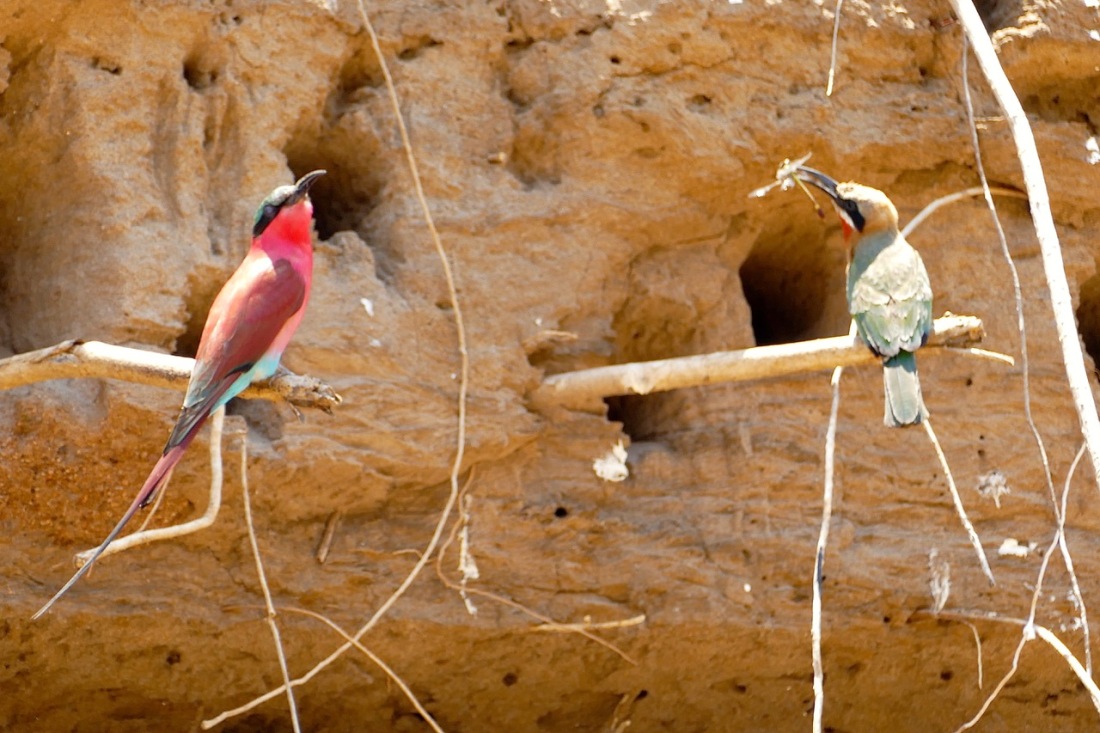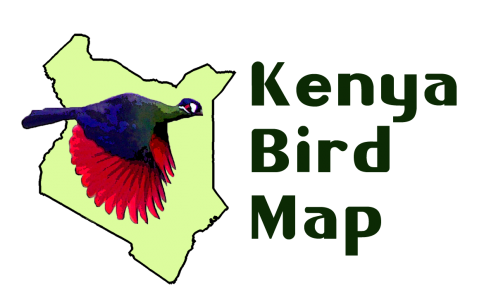The Kenya Bird Map is part of the greater African Bird Atlas, which covers the entire continent. Many parts of Africa are still poorly atlassed and we encourage our Kenya Bird Mappers to do some atlassing whenever they visit other countries, in order to help increase the Atlas’ coverage. Abigail Church, a Kenyan atlasser, recently spent several days atlassing in Zambia where she managed to do 17 cards (10 full protocols and 7 ad-hocs)! Below is a trip report.
Article and photos by Abigail Church
Day 1 – Lilayi Lodge, Lusaka
Arriving in Lusaka mid-afternoon on Kenya Airways was straightforward and soon we were driving through seemingly endless low-rise suburbs. The capital has a grid pattern of streets that extends well beyond the centre and as it darkened we felt as if we would never get to Lilayi!
The following morning, I opened the door of our banda to a pair of charmingly busy Red-throated (or Peter’s) Twinspots shuffling through the dry leaf matter – and instantly I was inspired to bird. A Schalow’s Turaco was calling and Helmeted Guineafowl were foraging too. We walked for an hour or so in the dry forest, Lilayi is a game ranch into which have been introduced many herbivores; southern giraffe, Leichtenstein’s hartebeest, klipspringer, blue wildebeest, tsessebe, sable and roan antelope but no dangerous game – and there are many easy walking paths that guests are free to explore. There wasn’t time to complete a full protocol card but the following are what we did see in an hour or so: Red-headed Weaver, Common Bulbul, Red-throated Twinspot, Schalow’s Turaco, Fiery-necked Nightjar, Black-collared Barbet, White-crested Helmetshrike, Blue Waxbill, Lizard Buzzard, Cape Turtle Dove, Emerald-spotted Wood Dove, Grey Heron, Helmeted Guineafowl, Black-backed Puffback, Southern Masked Weaver, Tawny-flanked Prinia.
Days 2-5 – Chongwe River House, Lower Zambezi (Western end)
We flew from Lilayi’s own airstrip southeast to the western end of Lower Zambezi National Park. It was sad to see how much of the area between Lusaka and the Zambezi Valley had been deforested by charcoal burners. The valley itself though is breathtaking with Africa’s fourth major river snaking east in a slow and lazy way, in places wide and in others divided into braided channels with low sandy islands tapered at either end. The terrain varies from Faidherbia woodland to dry bush. It was the end of the dry season and so much of the wildlife was concentrated on the riverbanks and in the shade of the forest.
Chongwe River House is located on the Chongwe which is a tiny river flowing properly only in the wet season when it rains on the escarpment above. At this time of year it just back floods from the Zambezi about 500m from the junction. Water birds were fun, many of course identical to those in Kenya. It was interesting to see that the European Bee-Eaters had already made their way down that far. We walked, canoed and went out onto the Zambezi by boat and had superb opportunities to bird throughout. I loved watching the Black Heron fishing – you just cannot help but smile each time he puts up his umbrella, concentrating so hard. Highlights for me included a pair of noisy Burnt-necked Eremomelas flitting around in the canopy of a couple of Faiderbia albida on the banks of the Zambezi, and getting dizzy trying to focus on Livingstone’s Flycatcher – a terrifically enigmatic little bird – which simply wouldn’t sit still! The Faiderbia forest was a particularly interesting area, busy with White-crested Helmet Shrikes, Meve’s Starlings and within which elephant shambled their way through picking up any fallen seeds on their way to the river to drink.

Days 6-9 – Amanzi, Lower Zambezi (Eastern end)
We transferred downstream to Amanzi by boat to the far eastern end of Lower Zambezi NP. This camp had a somewhat different feel being situated on a channel of the main river. The area was especially productive for carnivores at night and we saw leopard and lion on every night drive – one notable evening we found two male leopard squabbling over a kill, one remained in the tree whilst the larger of the two grabbed a fallen morsel and headed off with it grumbling. Then a third male appeared and climbed up to try and steal a bite but was seen off by the victor in the tree. As he descended a pair of hyena arrived and there was a snarling stand off before the leopard slunk away.
We had a really superb sighting here of a pair White-backed Night Herons which were nesting in tangled mass of vegetation by the river. I feel that this is one of those birds whose picture in bird books doesn’t do it justice, it is almost spookylooking with large dark eyes and a way of standing so still you can barely see it.

We spent one whole day exploring the Zambezi downstream boating through the
Mapata Gorge – where the river narrows to perhaps just 25m wide in places and
therefore flowing very fast and deep. Between the two camps and the gorge we
must have navigated over 75km of the Zambezi and came to within about 5km of
the border with Mozambique. On the way back we spent probably an hour
beneath a noisy Southern Carmine Bee-eater colony – what a treat!

Days 10-15 – Bushcamps Trail (Chamilandu-Chindeni-Bilimungwe-Kuyenda),
South Luangwa
The Luangwa River rises on the border of Zambia and Tanzania and flows south, down a broad valley to meet the Zambezi on the border with Mozambique. We had six days in South Luangwa in a private concession held by Bushcamps Co. where they have built six small camps designed for walking safaris. This beautiful park has a different feel to Lower Zambezi, there is some Mopane and other open plains with ox-bows and lagoons fringed with large Jackalberry and Natal Mahogany trees. There are no giraffe in the Zambezi Valley, but here in the Luangwa there is a sub-species known as Thornicroft’s giraffe.
Given that the camps were mostly walking distance apart, the area was surprisingly diverse. The Luangwa River was broad and in places had high sandy banks with many Southern Carmine Bee-eater colonies. White-fronted Bee-eaters were numerous too as were the Little and we had a couple of sightings of the Swallow-tailed. We glimpsed a Bat Hawk one evening hunting along the sand banks. A Dickenson’s Kestrel was nesting in a hollow palm. There were many Southern Ground Hornbill family groups too.

We had a superb sighting of Western Banded Snake Eagle at a waterhole and a Shikra drank as the former perched above. In another Mopane area we saw both Golden-breasted and Cinnamon-breasted Buntings. Another superb sighting was of a pair of Orange-winged Pytillias in a tall Mopane.
The most amusing though, was one evening when we were enjoying sundowners at Kuyenda. We were trying to figure out the nightjar calls and our guide, Suzyo, mentioned that occasionally he had seen the Pennant-winged in the area. James suggested that I play the call. As I did one of our guests commented “I don’t know how any bird could hear that sound”. As soon as he finished speaking, whoosh – one flew right over my head and fluttered to the ground some way off!

Days 16-18 – Mwaleshi, North Luangwa
Our final destination was Mwaleshi, a tiny camp on the Mwaleshi River, a tributary of the Luangwa. Only 500 people visit North Luangwa NP each year and it is really only suitable for walking. There were some broad open plains and we had lion and leopard sightings on foot each day. Puku and Impala grazed the plains along with Crawshay’s zebra and Cookson’s wildebeest. We watched a family of Saddle-billed Storks displaying – three youngsters and their parents stretching their wings and extending their necks calling.
The season here is short, June – November. The camp is built again each year after the rains, the rooms were simple grass huts with mud floors. Shelves and screens all built from reeds and I couldn’t see a single nail in the entire construction.
We had a range of sunbirds again here with the Copper being the highlight for me. It was strange how through the entire trip we hadn’t seen an Ostrich or any bustards at all, and very few vultures – just a couple of White-backed and Hooded. Every morning we woke here to the call of the African Barred Owlet.
Day 19 – Lilayi Lodge, Lusaka
We had longer to explore Lilayi on our way back through Lusaka at the end of the trip. The sable antelope put on a good show and we also spotted a Lizard Buzzard. We walked through a burnt area of woodland and were treated to a number of Bronze-winged Coursers beautifully camouflaged against the charred earth.
We were really surprised that none of our bird apps covered Zambia – Stevenson
& Fanshawe doesn’t go far enough south, and Roberts extends only as far as the
Zambezi Valley.

